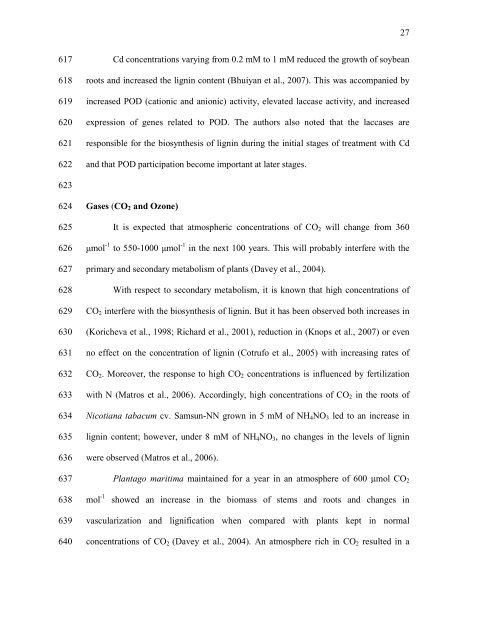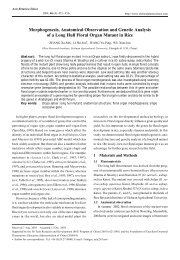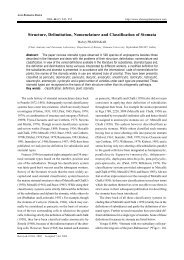Abiotic and biotic stresses and changes in the lignin ... - ResearchGate
Abiotic and biotic stresses and changes in the lignin ... - ResearchGate
Abiotic and biotic stresses and changes in the lignin ... - ResearchGate
You also want an ePaper? Increase the reach of your titles
YUMPU automatically turns print PDFs into web optimized ePapers that Google loves.
27<br />
617<br />
618<br />
619<br />
620<br />
621<br />
622<br />
Cd concentrations vary<strong>in</strong>g from 0.2 mM to 1 mM reduced <strong>the</strong> growth of soybean<br />
roots <strong>and</strong> <strong>in</strong>creased <strong>the</strong> lign<strong>in</strong> content (Bhuiyan et al., 2007). This was accompanied by<br />
<strong>in</strong>creased POD (cationic <strong>and</strong> anionic) activity, elevated laccase activity, <strong>and</strong> <strong>in</strong>creased<br />
expression of genes related to POD. The authors also noted that <strong>the</strong> laccases are<br />
responsible for <strong>the</strong> biosyn<strong>the</strong>sis of lign<strong>in</strong> dur<strong>in</strong>g <strong>the</strong> <strong>in</strong>itial stages of treatment with Cd<br />
<strong>and</strong> that POD participation become important at later stages.<br />
623<br />
624<br />
625<br />
626<br />
627<br />
628<br />
629<br />
630<br />
631<br />
632<br />
633<br />
634<br />
635<br />
636<br />
637<br />
Gases (CO 2 <strong>and</strong> Ozone)<br />
It is expected that atmospheric concentrations of CO 2 will change from 360<br />
μmol -1 to 550-1000 μmol -1 <strong>in</strong> <strong>the</strong> next 100 years. This will probably <strong>in</strong>terfere with <strong>the</strong><br />
primary <strong>and</strong> secondary metabolism of plants (Davey et al., 2004).<br />
With respect to secondary metabolism, it is known that high concentrations of<br />
CO 2 <strong>in</strong>terfere with <strong>the</strong> biosyn<strong>the</strong>sis of lign<strong>in</strong>. But it has been observed both <strong>in</strong>creases <strong>in</strong><br />
(Koricheva et al., 1998; Richard et al., 2001), reduction <strong>in</strong> (Knops et al., 2007) or even<br />
no effect on <strong>the</strong> concentration of lign<strong>in</strong> (Cotrufo et al., 2005) with <strong>in</strong>creas<strong>in</strong>g rates of<br />
CO 2 . Moreover, <strong>the</strong> response to high CO 2 concentrations is <strong>in</strong>fluenced by fertilization<br />
with N (Matros et al., 2006). Accord<strong>in</strong>gly, high concentrations of CO 2 <strong>in</strong> <strong>the</strong> roots of<br />
Nicotiana tabacum cv. Samsun-NN grown <strong>in</strong> 5 mM of NH 4 NO 3 led to an <strong>in</strong>crease <strong>in</strong><br />
lign<strong>in</strong> content; however, under 8 mM of NH 4 NO 3 , no <strong>changes</strong> <strong>in</strong> <strong>the</strong> levels of lign<strong>in</strong><br />
were observed (Matros et al., 2006).<br />
Plantago maritima ma<strong>in</strong>ta<strong>in</strong>ed for a year <strong>in</strong> an atmosphere of 600 μmol CO 2<br />
638<br />
mol -1<br />
showed an <strong>in</strong>crease <strong>in</strong> <strong>the</strong> biomass of stems <strong>and</strong> roots <strong>and</strong> <strong>changes</strong> <strong>in</strong><br />
639<br />
640<br />
vascularization <strong>and</strong> lignification when compared with plants kept <strong>in</strong> normal<br />
concentrations of CO 2 (Davey et al., 2004). An atmosphere rich <strong>in</strong> CO 2 resulted <strong>in</strong> a







